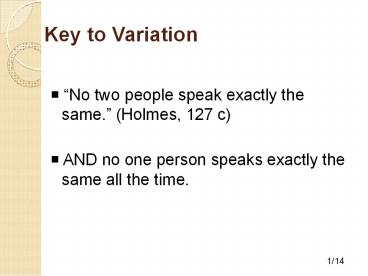Key to Variation - PowerPoint PPT Presentation
Title: Key to Variation
1
Key to Variation
- ? No two people speak exactly the same.
(Holmes, 127 c) - ? AND no one person speaks exactly the same all
the time.
1/14
2
Dialect vs Language
Crystal, David. The Cambridge Encyclopedia of
Language. Cambridge Cambridge University Press,
1987, p. 287.
2/14
3
Schematic Dialect Continuum
Crystal, David. The Cambridge Encyclopedia of
Language. Cambridge Cambridge University Press,
1987, p. 25.
3/14
4
Dialect Continua in Europe
Crystal, David. The Cambridge Encyclopedia of
Language. Cambridge Cambridge University Press,
1987, p. 25.
4/14
5
Dialect Chain Understanding your Neighbors
- The vernacular varieties of French spoken in
the border towns and villages of Italy, Spain,
and Switzerland, have more in common with the
language of the next village than the language of
Paris. From one village and town to the next
there is a chain or continuum.
Holmes, Janet. 2013. An Introduction to
Sociolinguistics, 4th edition. London Pearson,
pp 137-138.
5/14
6
What is a Language?
- So a language can be thought of as a collection
of dialects that are usually linguistically
similar, used by different social groups who
choose to say they are speakers of one language
which functions to unite and represent them to
other groups.
Holmes, Janet. 2013. An Introduction to
Sociolinguistics, 4th edition. London Pearson,
p. 138.
6/14
7
Social and Regional Accent Variation
Highest class RP
Social variation
Lowest class local accents
Regional variation
Holmes, Janet. 2013. An Introduction to
Sociolinguistics, 4th edition. London Pearson,
p. 139.
7/14
8
British Social Dialect Vocabulary 1 (1950s)
- U non-U
- have a bath take a bath
- bike, bicycle cycle
- luncheon dinner
- riding horse riding
- sick ill
- knave jack
- mad mental
- looking-glass mirror
- writing-paper note paper
- jam preserve
Crystal, David. The Cambridge Encyclopedia of
Language. Cambridge Cambridge University Press,
1987, p. 39. From A.S.C. Ross, 1954.
8/14
9
British Social Dialect Vocabulary 2 (1950s)
- U non-U
- wireless radio
- table-napkin serviette
- lavatory-paper toilet-paper
- rich wealthy
- vegetables greens
- pudding sweet
- telegram wire
- England Britain
- Scotch Scottish
Crystal, David. The Cambridge Encyclopedia of
Language. Cambridge Cambridge University Press,
1987, p. 39. From A.S.C. Ross, 1954.
9/14
10
Syntax Differences and Dialect
- (a) Ive not washed the dishes yet today.
- (b) I havent washed the dishes yet today.
- Both standard
- (c) They have got along well for many years.
- (d) They have gotten along well for many years.
- Regional Variation
- (e) I dont have any money.
- (f) I dont have no money.
- Social Variation
10/14
11
- h -Dropping
Holmes, Janet. 2013. An Introduction to
Sociolinguistics, 4th edition. London Pearson,
p. 146.
11/14
12
-ing / -in
Table 6.2 Percentage of vernacular in
pronunciation for four social groups in speech
communities in Britain, America, and
Australia Social group1 1 2 3 4 Norwich 31 42 91
100 West Yorkshire 5 34 61 83 New
York 7 32 45 75 Brisbane 17 31 49 63 Note 1 1
is the highest group 4 the lowest.
Holmes, Janet. 2013. An Introduction to
Sociolinguistics, 4th edition. London Pearson,
p. 146.
13
Post-Vocalic r
Holmes, Janet. 2013. An Introduction to
Sociolinguistics, 4th edition. London Pearson,
p. 148.
13/14
14
Vernacular 3rd Person Present Tense (she walks /
she walk)
Holmes, Janet. 2013. An Introduction to
Sociolinguistics, 4th edition. London Pearson,
p. 152.
14/14































